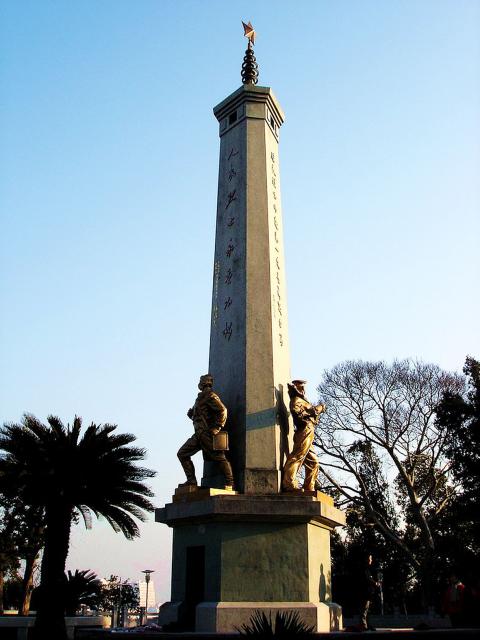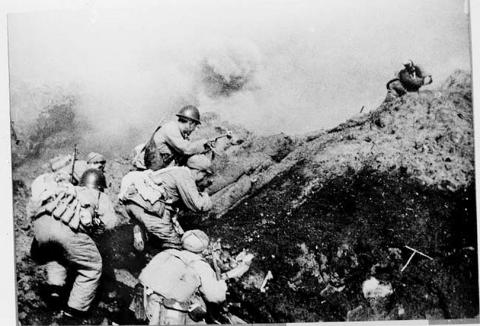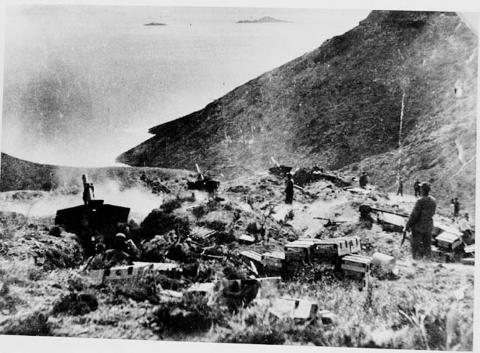Jan. 13 to Jan. 19
The battle began when People’s Liberation Army (PLA) warplanes blasted Yijiangshan Island (一江山) in the morning of Jan. 18, 1955. They then heavily shelled the uninhabited rock, just 1.24km square in area, for about three hours before commencing the ground invasion.
The defending Republic of China (ROC) troops knew they had no chance of winning, but they had signed a blood pledge to fight the enemy to the bitter end. Chinese Nationalist Party (KMT) leader Chiang Kai-shek (蔣介石) had given the following instructions: “Guarding [Yijiangshan] for a day will raise the spirits of people in Taiwan; guarding it for two days will strike terror into the Chinese communists; and guarding it for three days will reverse the attitude of the White House.”

Photo courtesy of Wikimedia Commons
The Ministry of National Defense states that the troops held out for over 61 hours, and in the afternoon of Jan. 20, commander Wang Sheng-ming (王生明) radioed the ROC army base in nearby Dachen Island: “The enemy is just 50 meters away. In my hand is a grenade I have saved for myself,” before pulling the pin.
The government in Taiwan declared that all 720 ROC troops on Yijiangshan sacrificed their lives while killing over 3,000 enemies; the Chinese side claims that they killed 519 and captured 567 ROC troops while losing 393 of their own. The fact that the ROC troops didn’t all die was confirmed in 2011 when one of the prisoners, Chen Hsiao-pin (陳小斌), was allowed to visit Taiwan.
Nevertheless, the troops fought a valiant battle, although Chiang has been criticized for sending them into an unwinnable fight for political means and to keep the nation’s war spirit up. The government, however, maintained that the battle did change the White House’s position as the Americans were moved by the troops’ bravery, contributing to the security of Taiwan for the next 60 years.

Photo courtesy of Wikimedia Commons
TESTING THE TREATY
During the 1950 to 1953 Korean War, relative calm settled over the two sides, as the US Navy’s Taiwan Patrol Force “neutralized” the Taiwan Strait.
This blockade was lifted in February 1953 and hostilities resumed. Chiang pressed the US to sign a formal agreement to defend Taiwan, but to no avail.

Photo courtesy of Wikimedia Commons
In August 1954, then-Chinese premier Zhou Enlai declared “Taiwan must be liberated,” and the Chinese military started shelling Kinmen, Matsu and Dachen islands off the Chinese coast.
M. Taylor Fravel writes in Strong Borders, Secure Nation that the Chinese intensified its attacks that year to deter the US and Taiwan from signing a defense treaty. Instead, it expedited treaty negotiations.
That December, Taiwan and the US signed the Sino-American Mutual Defense Treaty. The US naturally had its own objectives: while protecting Taiwan from attack, the treaty also essentially curbed Taiwanese aggression toward China. As a result, the US avoided direct conflict with China or the Soviet Union.

Photo courtesy of Wikimedia Commons
Beijing was afraid that the offshore islands would be included in the treaty since that would “embolden Chiang to conduct more raids against the mainland and also greatly weaken China’s ability to seize Kinmen and Matsu as steps toward an attack on Taiwan,” Fravel writes.
Fravel adds that in addition to removing the KMT presence from the coast of Zhejiang Province, the Chinese attacked Yijiangshan to “probe the treaty’s scope,” as it only explicitly mentions Taiwan and Penghu. During the invasion, the PLA troops were given instructions to actively avoid any conflict with US forces.
Jonathan M. House writes in A Military History of the Cold War, 1944-1962 that “once the PLA seized Yijiangshan, [then-US president Dwight] Eisenhower felt compelled to respond diplomatically. Just nine days after the battle commenced, Congress almost unanimously passed the Formosa Resolution, which authorized Eisenhower to defend not only Taiwan, but “such related positions and territories that are now in friendly hands … as he judges to be required or appropriate.”

Photo courtesy of Wikimedia Commons
CALLING FOR PATRIOTISM
It’s evident Communist aggression toward Yijiangshan did spur the US to immediate action, but did Chiang need to purposely send so many men into a doomed fight just to make a statement?
Wang’s son, Wang Ying-wen (王應文), thinks so, even though he acknowledges that the battle was for political, not military, purposes. His father’s sacrifice was worth it, he writes, as it rallied the patriotic spirit of people in Taiwan. It was also the fierceness and the determination of the troops that alerted the Americans to the urgency of the situation, and Wang believes that their mission was accomplished despite losing the battle.
For the next few decades, the government used the sacrifices in the Battle of Yijiangshan as a rallying cry for patriotism. Two months after the events, Chiang spoke at a Youth Day event commemorating the 72 Martyrs of Huanghuagang who died during the Second Guangzhou Uprising against the Qing Empire.
The number of dead at Yijiangshan was conveniently tallied at 720, exactly 10 times that of the Huanghuagang uprising, and Chiang urged the youth of Taiwan to follow their lead and give their lives for his cause to retake China.
“On this Youth Day, the youth of our nation are especially proud of … the 720 martyrs who died 70 days earlier at Yijiangshan. This is a new historic epic of our revolutionary youth that will pierce the sun and moon and will be sung and mourned … As you can see, thousands and thousands of patriotic youth in [Taiwan] have been inspired by the heroic sacrifices at Yijiangshan, and have joined the ranks of our revolutionary army, determined to fight the communists and save our nation!”
On the one year anniversary of the event, Chiang’s son, Chiang Ching-kuo (蔣經國), also urged people to follow the lead of the dead soldiers: “The Battle of Yijiangshan has rallied the spirits of our nation’s soldiers and civilians. In such a fierce battle on such a tiny island, our troops refused to surrender and all of them perished. This has inspired bravery in our people, and strengthened our resolve to emulate the martyrs of Yijiangshan and continue the fight to destroy the communists.”
Chiang Ching-kuo added that he is “very ashamed today, because I am still alive. I cannot face the martyrs of Yijiangshan. They have submitted their exam to the test of time, and have received full marks. Our exams are still blank. So how can we not be ashamed to still be alive? But we should be optimistic and excited, as the spirit of Yijiangshan tells us that if we continue to sacrifice ourselves, we will be the victors in the end.”
The next “opportunity” would come soon with the Second Taiwan Strait Crisis of 1958.
Taiwan in Time, a column about Taiwan’s history that is published every Sunday, spotlights important or interesting events around the nation that have anniversaries this week.

From an anonymous office in a New Delhi mall, matrimonial detective Bhavna Paliwal runs the rule over prospective husbands and wives — a booming industry in India, where younger generations are increasingly choosing love matches over arranged marriage. The tradition of partners being carefully selected by the two families remains hugely popular, but in a country where social customs are changing rapidly, more and more couples are making their own matches. So for some families, the first step when young lovers want to get married is not to call a priest or party planner but a sleuth like Paliwal with high-tech spy

The latest military exercises conducted by the People’s Liberation Army (PLA) last week did not follow the standard Chinese Communist Party (CCP) formula. The US and Taiwan also had different explanations for the war games. Previously the CCP would plan out their large-scale military exercises and wait for an opportunity to dupe the gullible into pinning the blame on someone else for “provoking” Beijing, the most famous being former house speaker Nancy Pelosi’s visit to Taiwan in August 2022. Those military exercises could not possibly have been organized in the short lead time that it was known she was coming.

With raging waters moving as fast as 3 meters per second, it’s said that the Roaring Gate Channel (吼門水道) evokes the sound of a thousand troop-bound horses galloping. Situated between Penghu’s Xiyu (西嶼) and Baisha (白沙) islands, early inhabitants ranked the channel as the second most perilous waterway in the archipelago; the top was the seas around the shoals to the far north. The Roaring Gate also concealed sunken reefs, and was especially nasty when the northeasterly winds blew during the autumn and winter months. Ships heading to the archipelago’s main settlement of Magong (馬公) had to go around the west side

When Portugal returned its colony Macao to China in 1999, coffee shop owner Daniel Chao was a first grader living in a different world. Since then his sleepy hometown has transformed into a bustling gaming hub lined with glittering casinos. Its once quiet streets are now jammed with tourist buses. But the growing wealth of the city dubbed the “Las Vegas of the East” has not brought qualities of sustainable development such as economic diversity and high civic participation. “What was once a relaxed, free place in my childhood has become a place that is crowded and highly commercialized,” said Chao. Macao yesterday